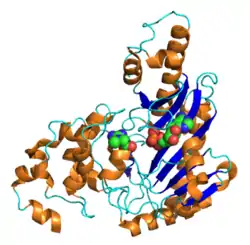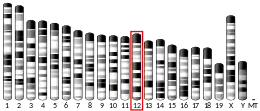CKB (gene)
Brain-type creatine kinase also known as CK-BB is a creatine kinase that in humans is encoded by the CKB gene.[5]
| creatine kinase, ectopic expression | |
|---|---|
| Identifiers | |
| Symbol | CKBE |
| NCBI gene | 1156 |
| HGNC | 1992 |
| OMIM | 123270 |
| Other data | |
| Locus | Chr. 14 q32.3 |
Function
The protein encoded by this gene, CK-BB, consists of a homodimer of two identical brain-type CK-B subunits. BB-CK is a cytoplasmic enzyme involved in cellular energy homeostasis, with certain fractions of the enzyme being bound to cell membranes, ATPases, and a variety of ATP-requiring enzymes in the cell. There, CK-BB forms tightly coupled microcompartments for in situ regeneration of ATP that has been used up. The encoded protein reversibly catalyzes the transfer of "energy-rich" phosphate between ATP and creatine or between phospho-creatine (PCr) and ADP. Its functional entity is a homodimer (CK-BB) in brain and smooth muscle as well as in other tissues and cells such as neuronal cells, retina, kidney, bone, etc. In heart, a heterodimer (CK-MB) shahil consisting of one CK-B brain-type CK subunit and one CK-M muscle-type CK subunit is prominently expressed. The encoded CK-BB and CK-MB proteins are members of the ATP:guanido phosphotransferase protein family.[6]
Ectopic expression
Ectopic expression (CKBE) of the B (brain) type of creatine kinase (CK-BB) in red cells and platelets is a rare, benign anomaly detected during a newborn screening program for Duchenne muscular dystrophy.[7][8]
References
- GRCh38: Ensembl release 89: ENSG00000166165 - Ensembl, May 2017
- GRCm38: Ensembl release 89: ENSMUSG00000001270 - Ensembl, May 2017
- "Human PubMed Reference:". National Center for Biotechnology Information, U.S. National Library of Medicine.
- "Mouse PubMed Reference:". National Center for Biotechnology Information, U.S. National Library of Medicine.
- Mariman EC, Schepens JT, Wieringa B (August 1989). "Complete nucleotide sequence of the human creatine kinase B gene". Nucleic Acids Res. 17 (15): 6385. doi:10.1093/nar/17.15.6385. PMC 318286. PMID 2771648.
- "Entrez Gene: CKB".
- Kotz R, Leber H, Ramach W, Arbes H, Wolf A (July 1977). "[Clinical observations on the use of high-dose methotrexate treatment in osteogenic sarcoma (author's transl)]". Wien. Klin. Wochenschr. (in German). 89 (14): 474–9. PMID 70889.
- Wienker TF, Ulferts A, Ott J, Bender K, Scheuerbrandt G, Arnold H, Ropers HH (1985). "A dominant mutation causing ectopic expression of the creatine kinase B gene maps on chromosome 14". Cytogenet. Cell Genet. 40: 776. doi:10.1159/000316956.
External links
- Creatine+Kinase,+BB+Form at the US National Library of Medicine Medical Subject Headings (MeSH)
- Human CKB genome location and CKB gene details page in the UCSC Genome Browser.
This article incorporates text from the United States National Library of Medicine, which is in the public domain.




